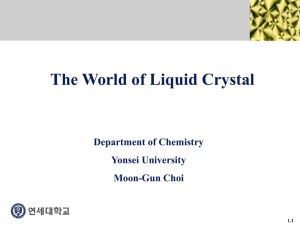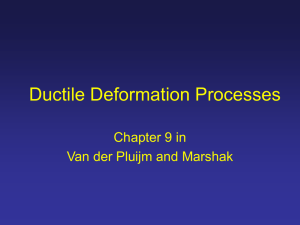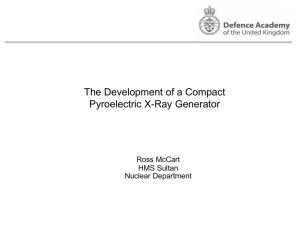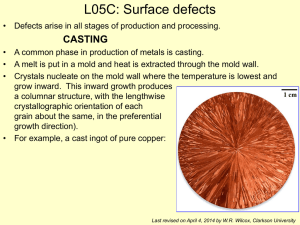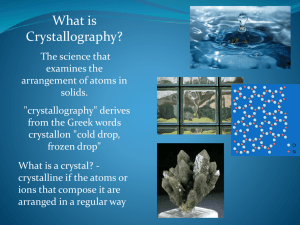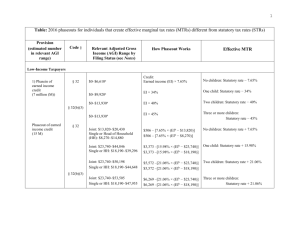Homework - Purdue University
advertisement
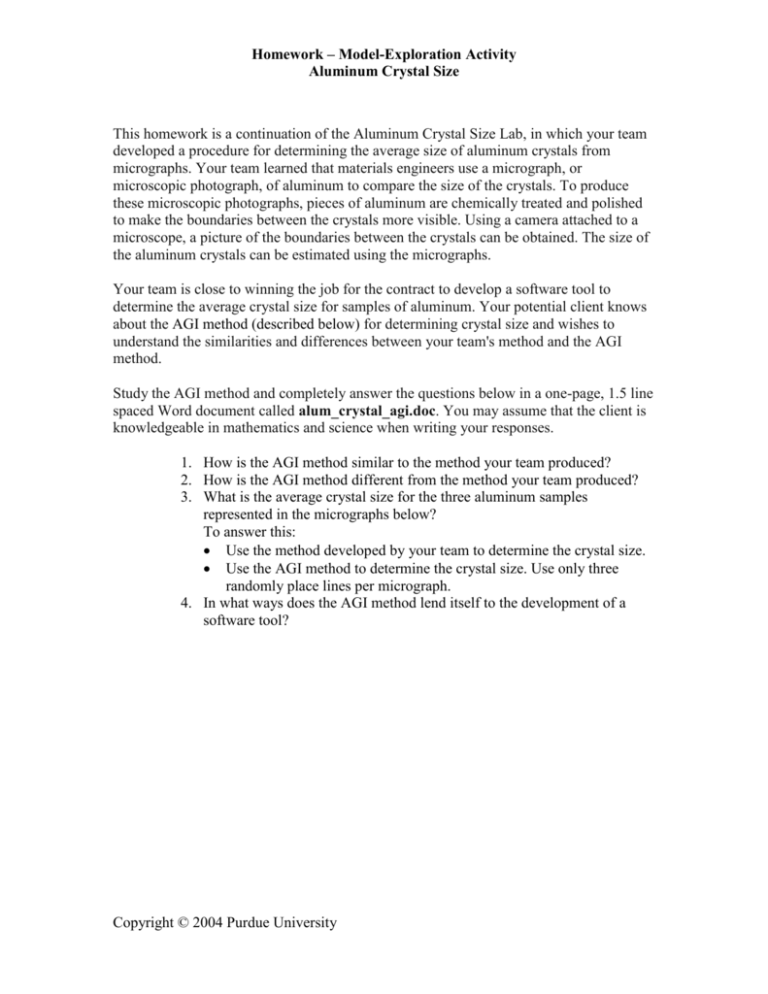
Homework – Model-Exploration Activity Aluminum Crystal Size This homework is a continuation of the Aluminum Crystal Size Lab, in which your team developed a procedure for determining the average size of aluminum crystals from micrographs. Your team learned that materials engineers use a micrograph, or microscopic photograph, of aluminum to compare the size of the crystals. To produce these microscopic photographs, pieces of aluminum are chemically treated and polished to make the boundaries between the crystals more visible. Using a camera attached to a microscope, a picture of the boundaries between the crystals can be obtained. The size of the aluminum crystals can be estimated using the micrographs. Your team is close to winning the job for the contract to develop a software tool to determine the average crystal size for samples of aluminum. Your potential client knows about the AGI method (described below) for determining crystal size and wishes to understand the similarities and differences between your team's method and the AGI method. Study the AGI method and completely answer the questions below in a one-page, 1.5 line spaced Word document called alum_crystal_agi.doc. You may assume that the client is knowledgeable in mathematics and science when writing your responses. 1. How is the AGI method similar to the method your team produced? 2. How is the AGI method different from the method your team produced? 3. What is the average crystal size for the three aluminum samples represented in the micrographs below? To answer this: Use the method developed by your team to determine the crystal size. Use the AGI method to determine the crystal size. Use only three randomly place lines per micrograph. 4. In what ways does the AGI method lend itself to the development of a software tool? Copyright © 2004 Purdue University Homework – Model-Exploration Activity Aluminum Crystal Size Average Grain Intercept (AGI) Method The average grain intercept (AGI) method is a technique used to quantify the grain - or crystal - size for a given material by drawing a set of randomly positioned line segments on the micrograph, counting the number of times each line segment intersects a grain boundary, and finding the ratio of line length to number of intercepts. Thus, the AGI is calculated as: AGI line length number of intercepts A sample with small crystals will have a low AGI value compared to a sample with large crystals. Figure 1 shows a micrograph (microscopic photograph) of a metal sample that has been polished to produce a smooth flat surface and then etched to highlight the boundaries between crystals (or grains). The material within each boundary is a single, or individual, crystal that has been intersected (i.e., sliced through) by the polishing plane. On this micrograph the micron marker indicates the magnified size of the features. A micron marker is more useful than giving the magnification (number of times X) since the micron marker is always scaled properly even when subsequent enlargements or reductions are made of the micrograph. The line segments that are randomly superimposed on the micrograph of Figure 1 show the first step in determining the AGI (average grain intercept). The small squares on one of the line segments indicate (approximately) where the line segment intersects the grain (crystal) boundaries. To calculate the AGI, the intersections for the other randomly placed line segments would also need to be obtained. The count of boundaries and the total length of the line segments would then be used to calculate the AGI for the sample. | | 0.1 mm Figure 1. Micrograph of Crystals with Random Line Segments Copyright © 2004 Purdue University Homework – Model-Exploration Activity Aluminum Crystal Size The picture shown in Figure 1 is a digitized, gray scale image of the view seen in an optical microscope. The reason that the grain boundaries are darker than the grains themselves is that the acid used to etch the surface preferentially removes material at the grain boundaries. This results in a sample with channels or mini-canyons running along the grain boundaries. Along these boundaries, the light used to illuminate the sample is not reflected back into the microscope eyepiece. This produces the observed variation in gray scales shown in Figure 1. A digitization of Figure 1 can be stored in as a data file which contains an array of numbers where each number refers to the gray scale value for each pixel of the micrograph. A sub-sample of the complete Figure 1 file is shown in Table 1; this sub-sample shows the gray scale values for the square superimposed on Figure 2 and exploded in by itself in Figure 3. Gray scale values range from 0 for black to 255 for white. Figure 2. Micrograph of crystals with sub-sample shown. Figure 3. Sub-sample of micrograph shown in Figure 2. Table 1. Digital file for sub-sample from micrograph of crystals shown in Figure 3. 131 95 79 100 16 66 8 54 19 16 31 11 23 13 11 17 15 19 15 17 13 15 11 13 10 13 10 14 13 15 15 17 38 37 33 15 81 86 31 20 70 81 36 27 81 118 61 37 40 98 95 48 38 102 107 57 34 70 97 77 29 31 90 103 19 24 43 93 18 22 30 44 15 20 26 15 14 19 26 23 14 20 18 27 15 20 13 19 16 21 17 22 16 20 23 32 12 17 22 23 20 23 55 99 87 45 20 27 35 30 23 18 19 13 8 10 12 12 14 3 7 16 7 10 18 19 16 15 11 13 16 7 12 18 15 16 10 16 18 24 20 19 16 9 18 5 19 22 25 28 24 19 15 22 6 22 22 20 20 20 22 23 20 8 20 15 35 18 21 26 22 16 15 25 13 64 30 32 34 21 19 28 37 22 58 21 36 25 25 27 30 31 33 56 55 53 45 59 48 51 57 83 49 91 92 90 98 120 120 106 113 37 101 122 122 100 136 128 99 99 35 92 112 102 67 54 41 17 37 47 81 78 56 38 30 27 20 34 48 59 52 27 28 11 16 22 19 32 30 39 19 25 24 17 20 12 Copyright © 2004 Purdue University 16 18 12 15 7 13 10 18 18 25 22 26 32 37 50 57 47 78 99 110 84 64 58 39 27 22 27 18 14 8 25 22 Homework – Model-Exploration Activity Aluminum Crystal Size Sample Aluminum Micrographs Copyright © 2004 Purdue University



